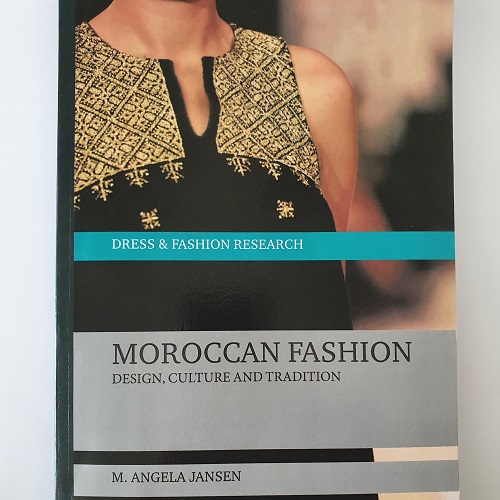Author: M. Angela Jansen
Publisher: Bloomsbury Academic, 2015
Format and Layout
156 x 234 x 13 mm (6.14" x 9.21" x 0.5”)
Softcover
160 pages
ISBN 978-1-4742-28522-3
Text and images on a white background
English
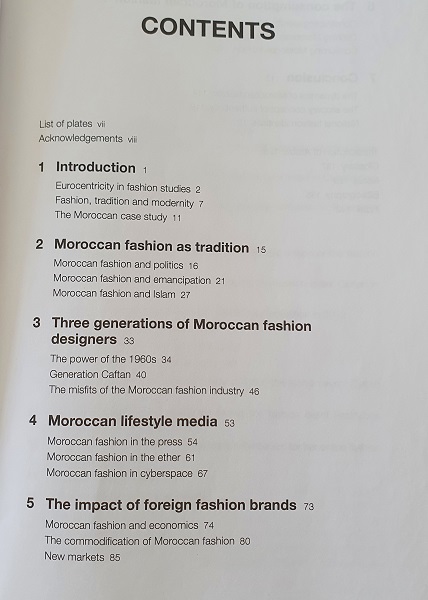
Photos, Illustrations and Diagrams
The book is in a small format, similar to a textbook, and is written as a scholarly text. It contains sixteen black-and-white photos, with no illustrations or diagrams. The only colour in the book is on the outside front and back cover.
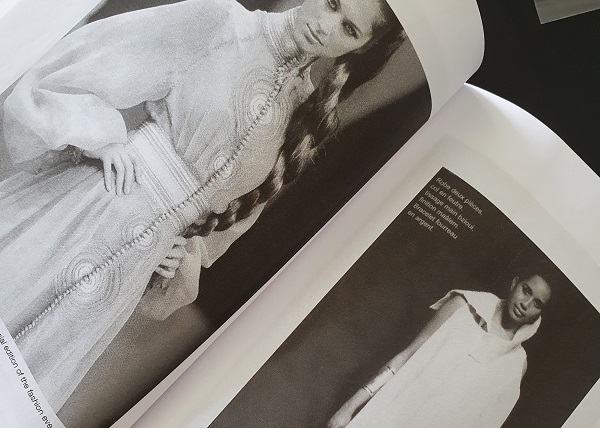
Introduction
“Moroccan garment design and consumption have experienced major shifts in recent history, transforming from a traditional craft-based enterprise to a thriving fashion industry. Influenced by western fashion, dress has become commoditised and has expanded from tailoring to designer labels. This book presents the first detailed ethnographic study of Moroccan fashion.
Drawing on interviews with three generations of designers and the lifestyle press, the author provides an in-depth analysis of the development of urban dress, which reveals how traditional dress has not been threatened but produced and consumed in different ways.
With chapters examining themes such as dress and politics, gender, faith, modernity, and exploring topics from craft to e-fashion, anthropology, material culture, sociology, cultural studies, gender studies and related fields.” Back cover blurb
This book is an extension of the author’s research and study for her PhD thesis on the same topic. It is part of a series of books on
Dress and Fashion Research published by Bloomsbury Academic.
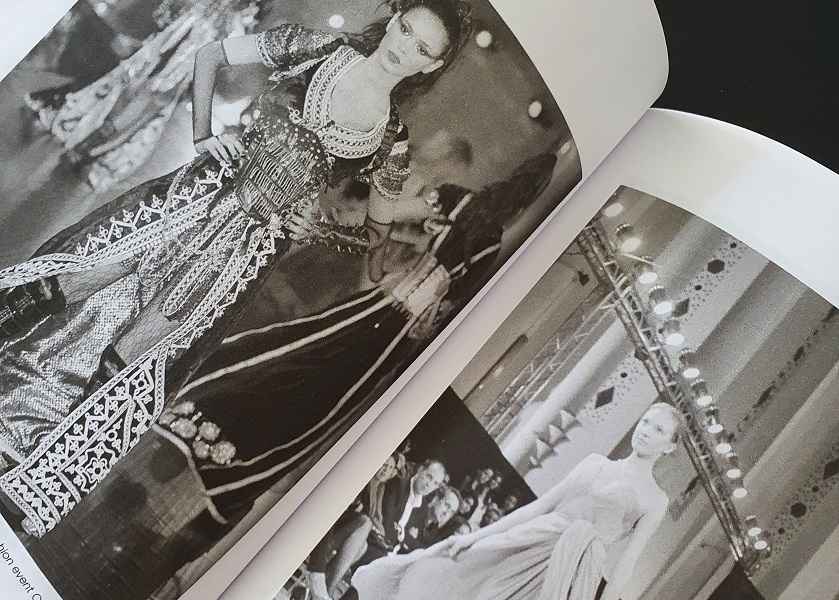
Content
The author explains the concept of the book in the Introduction chapter:
“After graduation, circumstances led me to focus on Moroccan fashion for my PhD research and it became even more obvious that so-called traditional dress is not only susceptible to change/fashion trends, but can even be subject to thriving fashion industry. In its turn, the Moroccan case study confronted me with yet another misconception I had developed through literature, which is that the arrival of foreign (European) fashion on a large scale does not automatically result in the disappearing of local fashion, but on the contrary, can boost its development through the introduction of new consumption patterns and marketing strategies. I came to realise that the interaction between local and foreign fashions is not necessarily conflicting, but can be a powerful tool in redefining notions of tradition and modernity as well as localness and globalness, and that these concepts are neither static nor mutually exclusive.
From that moment forwards my research took a completely different direction. The main aim of my research became to contest misconceptions concerning traditional dress as being static, authentic, symbolic rather than aesthetic and incompatible with (Euro)modernity.”
The book interprets Angela's research and studies in more depth using practical case studies, interviews, and references to politics, art, religion, media, economics, the internet, and other influences.
In the seven chapters she discusses:
- Introduction
- Moroccan fashion as tradition
- Three generations of Moroccan fashion designers
- Moroccan lifestyle media
- The impact of foreign fashion brands
- The consumption of Moroccan fashion
- Conclusion
The book concludes with a comprehensive glossary, notes, bibliography, and index, as well as a transcription of Arabic.
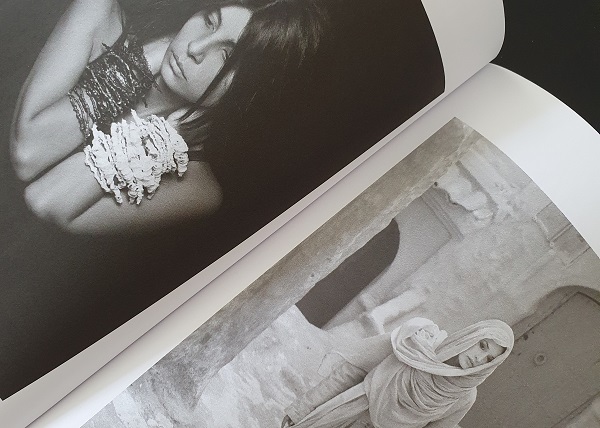
Conclusion
Angela’s book and research create an important and essential bridge between traditional fashion research (where the focus is on the garment itself rather than the context in which it was used) and the modern 21
st century take on fashion as a dynamic and evolving force empowered by culture and tradition rather than enslaved to it.
Angela’s research, although focused on Moroccan fashion, creates the impetus to look with fresh eyes at fashion history (both past and present) of other cultures and to recognise that tradition is not dying, it is evolving. It has never been static and it never will be.
This book validates a lot of the work that we have instinctively been doing at The
Zay
Zay: (Arabic: costume, Pl. azyaā’), a set of clothes in a style typical of a particular country or historical period. Initiative: Protecting, preserving, and documenting the tangible and intangible heritage of the past, while simultaneously encouraging and supporting current and contemporary traditional dress and design. As our tagline says: An ode to the past – a nod to the future.
“This is a well-researched body of work and much needed to contextualise the evolution of dress culture in Morocco. It also draws very interesting similarities with the dress culture in the UAE as it has evolved during the past fifty years.” Dr Reem el Mutwalli
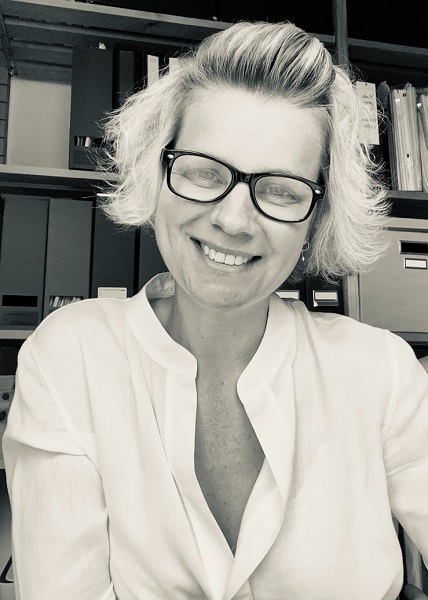
About the author
Angela Jansen is a fashion anthropologist and an independent researcher, educator, consultant and curator. She is a director at the
Research Collective for Decoloniality & Fashion (RCDF) and is based in Belgium.
She is the co-editor with Jennifer Craik of
Modern Fashion Traditions: Negotiating Tradition and Modernity Through Fashion (London: Bloomsbury, 2016).
She is the guest co-editor with Toby Slade of the special issue of
Fashion Theory on Decoloniality and Fashion (Vol 24(6) 2020).
Further Reading
Moroccan EmbroideryBook Review: Moroccan Textile Embroidery



